 "ttyymmnn" (ttyymmnn)
"ttyymmnn" (ttyymmnn)
03/19/2019 at 12:35 • Filed to: wingspan, Planelopnik, TDIAH
 7
7
 6
6
 "ttyymmnn" (ttyymmnn)
"ttyymmnn" (ttyymmnn)
03/19/2019 at 12:35 • Filed to: wingspan, Planelopnik, TDIAH |  7 7
|  6 6 |
!!! UNKNOWN CONTENT TYPE !!!
Welcome to
This Date in Aviation History
, getting of you caught up on milestones, important historical events and people in aviation from March 16 through March 19.
!!! UNKNOWN CONTENT TYPE !!!
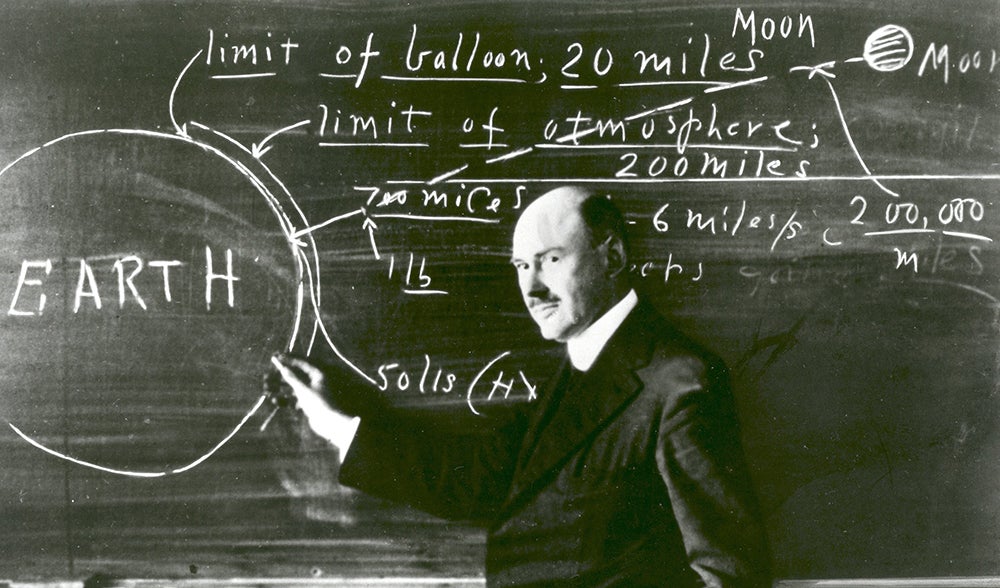
Robert Goddard at a blackboard at Clark University in Worcester, Massachusetts, in 1924 (NASA)
March 16, 1926 – Robert Goddard launches the first liquid-fuelled rocket. The earliest rockets date back to 13th century China, where there were used both as weapons and fireworks. Militarily, these solid-fueled projectiles became primarily weapons of siege warfare and, even as their development progressed, the fuel for the rockets remained relatively unchanged. Today, many rockets and missiles are still powered by solid fuels, but it was American Robert Goddard’s work with liquid-fueled rockets that helped to usher in the Space Age, and Goddard is generally accepted to be the father of space flight and modern rocketry.
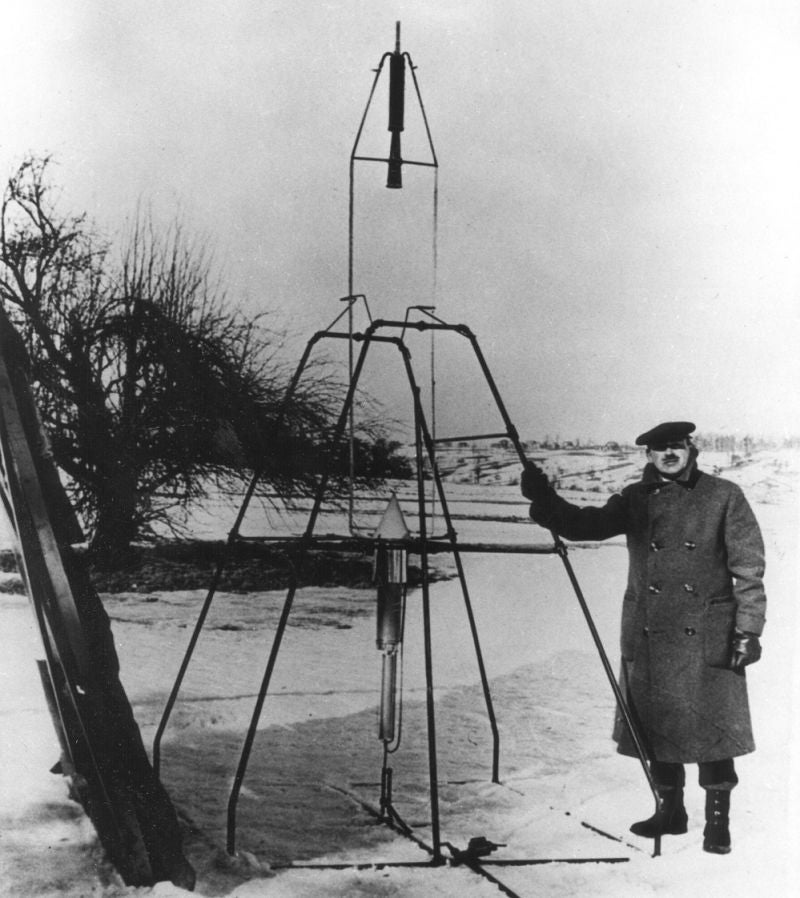
Robert Goddard poses with a liquid oxygen-gasoline rocket in its launching frame on March 16, 1926, at Auburn, Massachusetts (NASA)
Though Goddard is best known for his pioneering work with rockets, he was also a physicist and engineer who held 214 patents, and his groundbreaking work in the fields of rocketry and orbital theory became the basis for all those who followed. His work also led to developments in atmospheric research, ballistic missiles, and manned space travel. As a young boy, Goddard was influenced by the science fiction writings of !!!error: Indecipherable SUB-paragraph formatting!!! , particularly !!!error: Indecipherable SUB-paragraph formatting!!! , and he began to study the works of other inventors, such as !!!error: Indecipherable SUB-paragraph formatting!!! , who wrote about flight for Smithsonian Magazine. By 1913, Goddard was studying calculus and developed the mathematics that made it possible to calculate the position and velocity of a rocket in vertical flight, as well as the force necessary to get rockets of differing weights into the atmosphere. In 1919, the Smithsonian published A Method of Reaching Extreme Altitudes , a report in which Goddard discusses his work with rockets, the development of his mathematics, and his belief that rockets could one day travel to the Moon.
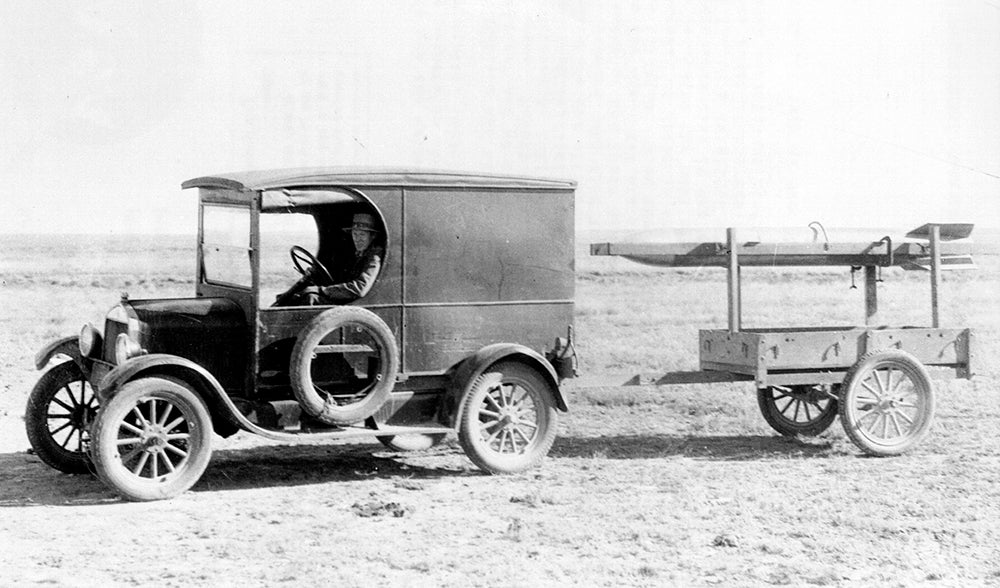
Robert Goddard tows a rocket to the launching tower behind a Model A Ford truck near Roswell, New Mexico circa 1931 (NASA)
Goddard began his experiments with solid-fuel rockets, but soon realized that, in order to gain the velocities necessary to reach space, he would need to use a !!!error: Indecipherable SUB-paragraph formatting!!! . When compared to solid-fuel rockets, liquid propellants have the benefit of providing greater power at lower volumes of fuel and provide a greater power to weight ratio. They also provide more control over the rocket’s flight. Once a solid rocket is ignited, its burn rate can only be controlled by the !!!error: Indecipherable SUB-paragraph formatting!!! of the fuel block, while use of a liquid fuel allows for the throttling of the rocket engine. Starting in 1921, Goddard began to experiment with liquid-fueled rockets using a liquid oxidizer, and he successfully tested the first rocket engine using a liquid propellant in 1923. His first successful launch using a rocket fueled with gasoline and liquid oxygen took place on March 16, 1926 at Auburn, Massachusetts. Though that first flight only lifted a mere 41 feet into the air, it demonstrated the potential of the liquid fuel engine. Goddard and his team launched a total of 33 rockets, and they eventually reached altitudes as high as 1.6 miles and speeds up to 550 mph.
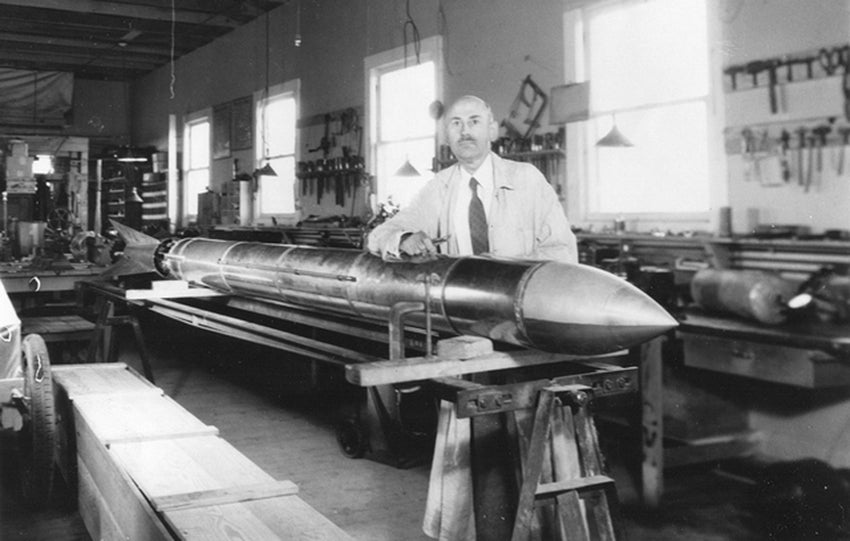
Robert Goddard with one of his later rockets in his workshop at Roswell, New Mexico, in October 1935 (NASA)
Along with his development of new fuels, Goddard also pioneered the means to control his rockets. He developed three-axis control, the use of gyroscopes for stability, and rockets with steerable thrust to direct the rocket in flight. His first rocket used static fins for stability, but later models employed gyroscopically controlled vanes in the exhaust, a method that was later copied by the Germans for use in the !!!error: Indecipherable SUB-paragraph formatting!!! rockets used to attack England in the later stages of WWII. Goddard also pioneered a system that steered the rocket nozzle itself, a control method that is still in use today. Unfortunately for Goddard, many in the US government and military failed to appreciate the importance of his work and, by the end of WWII, the Germans had far outpaced the US in rocket development, possibly using Goddard’s own data that had been transferred to Germany by spies in the US. However, in a bit of historical irony, the wartime advances made by Germans like !!!error: Indecipherable SUB-paragraph formatting!!! would return to the US following the war, when many captured German scientists were brought to the United States to work on America’s nascent space program. Nevertheless, Goddard’s work cemented him in the history of space exploration, and the !!!error: Indecipherable SUB-paragraph formatting!!! in Maryland, as well as the !!!error: Indecipherable SUB-paragraph formatting!!! on the Moon, are named in his honor.
!!! UNKNOWN CONTENT TYPE !!!
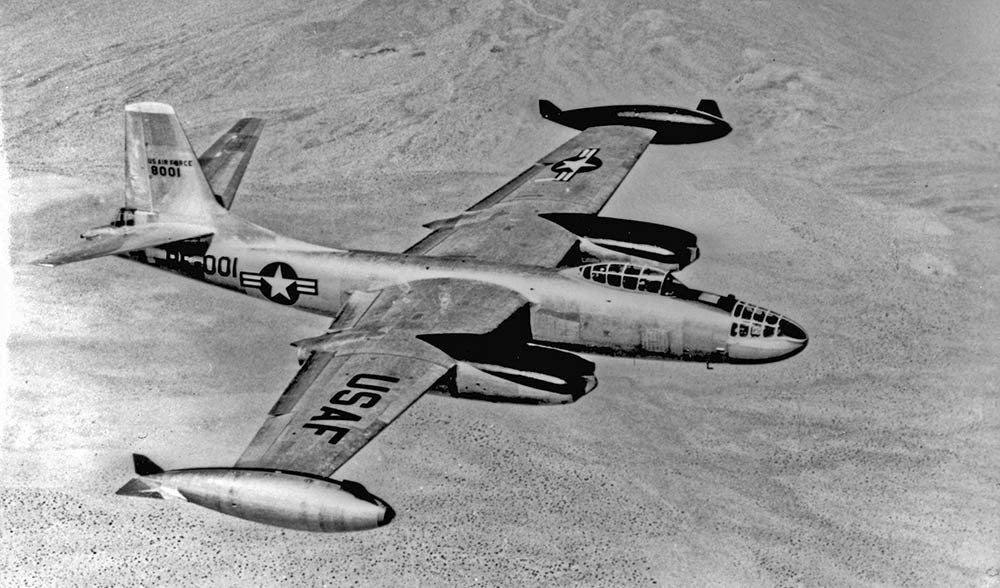
North American B-45C Tornado (US Air Force)
March 17, 1947 – The first flight of the North American B-45 Tornado. By the later stages of WWII, the arrival of jet-powered German bombers had the Allies scrambling to develop aircraft of their own. The Luftwaffe had already fielded the !!!error: Indecipherable SUB-paragraph formatting!!! , the world’s first operational jet bomber, and though it was only built in limited numbers, it was clear that the future lay in jet power. Work on the Tornado began in 1944 with a requirement from the US War Department for a new jet-powered bomber and, following submissions from several companies, the North American NA-130 was chosen as the winner on September 8, 1944.
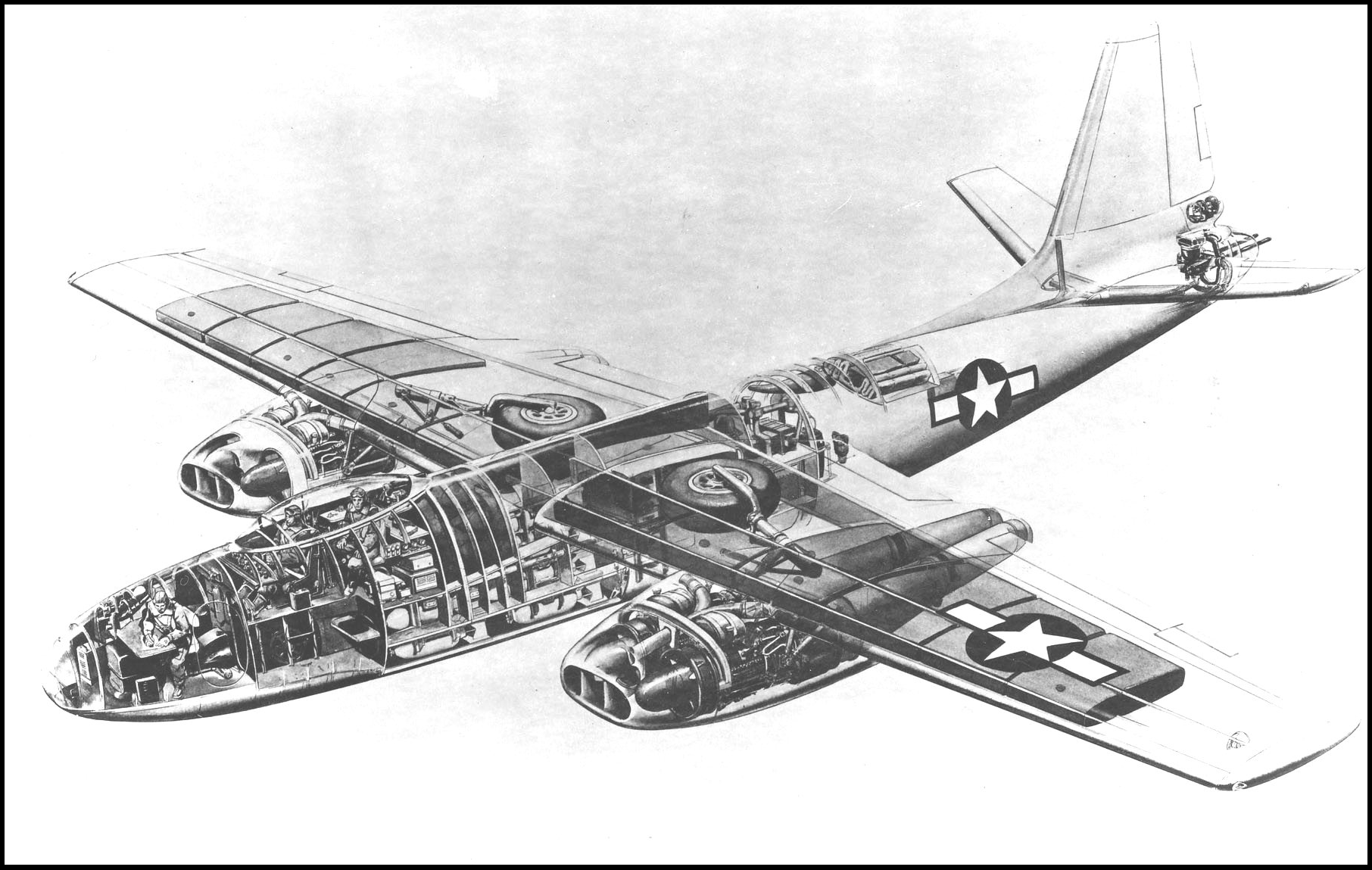
A cutaway drawing of the prototype XB-45 (US Air Force)
The idea of using a swept wing dates back to before WWI, and the Germans had begun to investigate the swept wing to reduce high-speed drag by the 1930s. But it wasn’t until after the war that captured German data made its way to the United States. Thus, the B-45, like many other early jet aircraft, still employed straight wings, and would not have looked out of place if it were given propeller engines. The Tornado was powered by four !!!error: Indecipherable SUB-paragraph formatting!!! turbojets housed in nacelles in the wing and had a maximum speed of 570 mph with a range of 1,000 miles while carrying up to 22,000 pounds of bombs. It was also armed with two .50 caliber machine guns in the tail for defense against fighters and had a crew of four: pilot, co-pilot, bombardier-navigator and tail gunner.
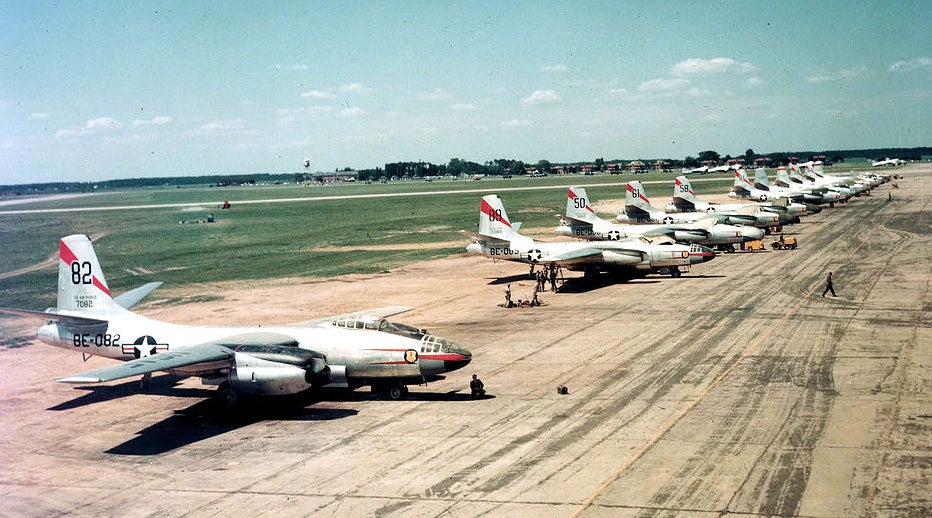
North American B-45 Tornadoes of the 47th Bombardment Wing on the tarmac at Langley Air Force Base in Virginia in 1952. (US Air Force)
By the end of WWII, technological advancements were beginning to outpace development and production schedules of many fighter and bomber programs. With the !!!error: Indecipherable SUB-paragraph formatting!!! starting to heat up, the Air Force placed special emphasis on nuclear-capable bombers, and a decision had to be taken whether to produce the B-45, or the !!!error: Indecipherable SUB-paragraph formatting!!! , which was similar to the Tornado in many respects, though much larger. After an evaluation, the B-45 was chosen as the better aircraft, and North American received a contract to produce the B-45 beginning in January 1947. But the Tornado soon became a victim of underpowered engines and the rapid advances of aircraft technology. The !!!error: Indecipherable SUB-paragraph formatting!!! , which benefitted from captured German data on swept wing design, took its maiden flight less than a year after the Tornado, and offered greater speed and almost twice the combat range. Reduced postwar military budgets also meant that the Air Force would have to limit the number of projects it could develop, and with the B-47 looming on the horizon, production of the B-45 was cut, resulting in a final production run of 143 aircraft. Nevertheless, the Tornado holds the distinction of being America’s first operational jet bomber and the world’s first multi-jet engined bomber to be refueled in midair.
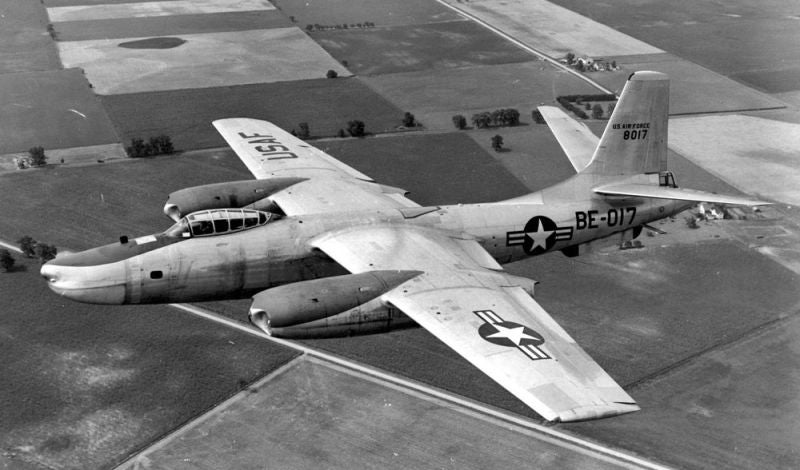
An RB-45C reconnaissance variant. Note the solid nose and camera port below and ahead of the cockpit. (US Air Force)
Despite its relatively short service life, the Tornado filled an vital gap in America’s and NATO’s nuclear deterrence force, particularly during the Korean War, when so many military assets had been sent to Asia. In 1952, B-45s were modified to carry nuclear bombs and sent to England, and the RB-45 reconnaissance variant provided valuable intelligence over Korea, where they complemented older !!!error: Indecipherable SUB-paragraph formatting!!! piston-powered reconnaissance aircraft that had proven vulnerable to enemy jet fighters. After the war, the Tornado made some overflights of the Soviet Union, but those missions were soon taken over by the !!!error: Indecipherable SUB-paragraph formatting!!! (the American-built !!!error: Indecipherable SUB-paragraph formatting!!! ), which could fly at higher altitudes. The B-45 was removed from active service by the end of the 1950s, though some served for a few more years as test aircraft.
!!! UNKNOWN CONTENT TYPE !!!
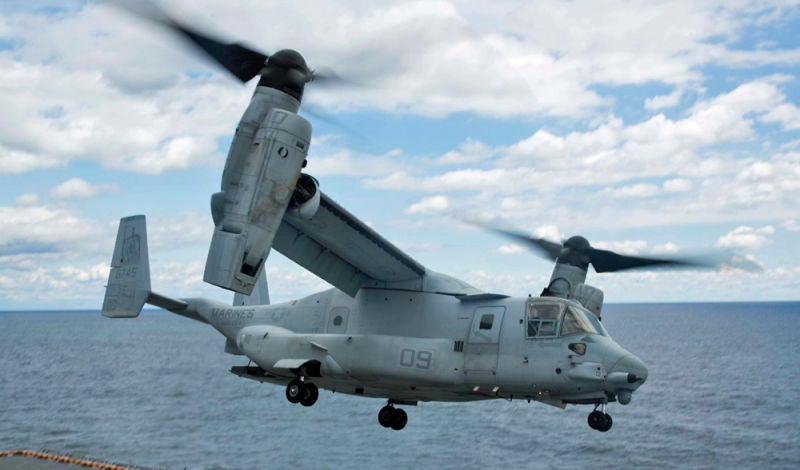
(US Navy)
March 19, 1989 – The first flight of the Bell Boeing V-22 Osprey.
When the helicopter entered military service shortly after WWII, it revolutionized ground warfare. No longer were airstrips or dangerous parachute drops necessary to deliver troops to a combat theater, and an entirely new concept of vertical envelopment entered military doctrine. But the helicopter has its limitations, particularly in speed. Due to its fundamental design, a traditional helicopter is limited to about 250 mph, well under the speeds that are attainable by an airplane. For many years, aircraft designers sought to get the best of both worlds by creating an aircraft that could take off vertically like a helicopter but then transition to horizontal flight like an airplane. Ideally, the rotors that lift the aircraft could then be used to pull it through the air.
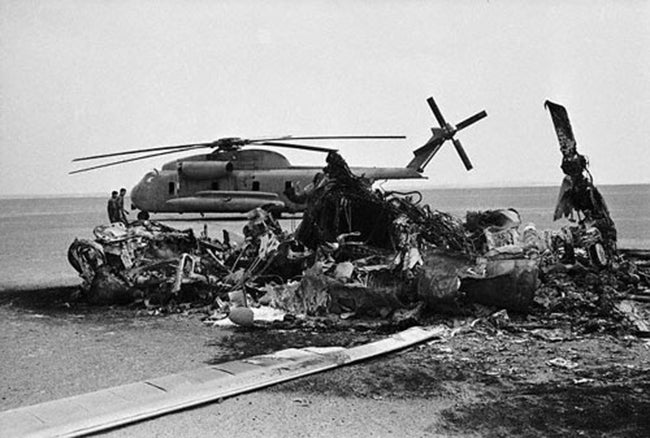 !!!CAPTION ERROR: MAY BE MULTI-LINE OR CONTAIN LINK!!!
!!!CAPTION ERROR: MAY BE MULTI-LINE OR CONTAIN LINK!!!
The problem of vertical or short takeoff flight (V/STOL) has been solved for smaller fighters such as the !!!error: Indecipherable SUB-paragraph formatting!!! , but V/STOL jets were never capable of carrying a useful payload of cargo or troops, though some !!!error: Indecipherable SUB-paragraph formatting!!! . But that all changed with the Osprey, when engine and control technology finally matured enough to develop a large aircraft that could make a meaningful contribution to military logistics and transport. The critical need for an aircraft such as the Osprey was demonstrated by !!!error: Indecipherable SUB-paragraph formatting!!! in 1980, the disastrous attempt to rescue 52 American hostages held at the American embassy in Tehran. At the time, the American fleet of large helicopters had neither the speed nor the range to carry out the rescue mission without highly orchestrated stops for fuel inside enemy territory, and an accident at a remote desert landing site lead to the deaths of nine personnel and the abandonment of the mission. What the Department of Defense desperately needed was an aircraft that could take off beyond the horizon, fly at high speed to a landing zone, then descend vertically like a helicopter.
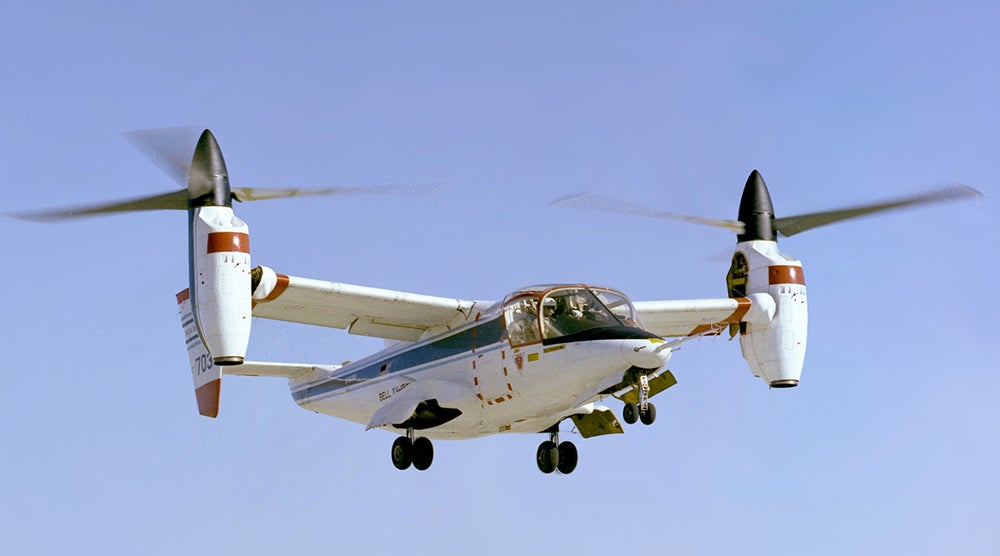
The Bell XV-15 tiltrotor research aircraft, sponsored by NASA and the US Army, first flew in 1977 (NASA)
The Osprey traces its lineage back to the !!!error: Indecipherable SUB-paragraph formatting!!! , which first flew in 1977 and proved that the concept of using tilting engine nacelles could provide superior performance to traditional helicopters. In 1981, work began on the Joint-service Vertical take-off/landing Experimental program (JVX) to create an aircraft with a large fuselage for troops or materiel, with turboprop engines in rotating nacelles at the end of short wings. The US Navy and Marine Corps were the lead branches in the development of the JVX based on their specific operational needs, and !!!error: Indecipherable SUB-paragraph formatting!!! partnered with !!!error: Indecipherable SUB-paragraph formatting!!! to produce six prototypes of the Osprey. Following testing, full-scale production began in 1986. The Osprey entered service in 2007, and over 200 have been built to date.
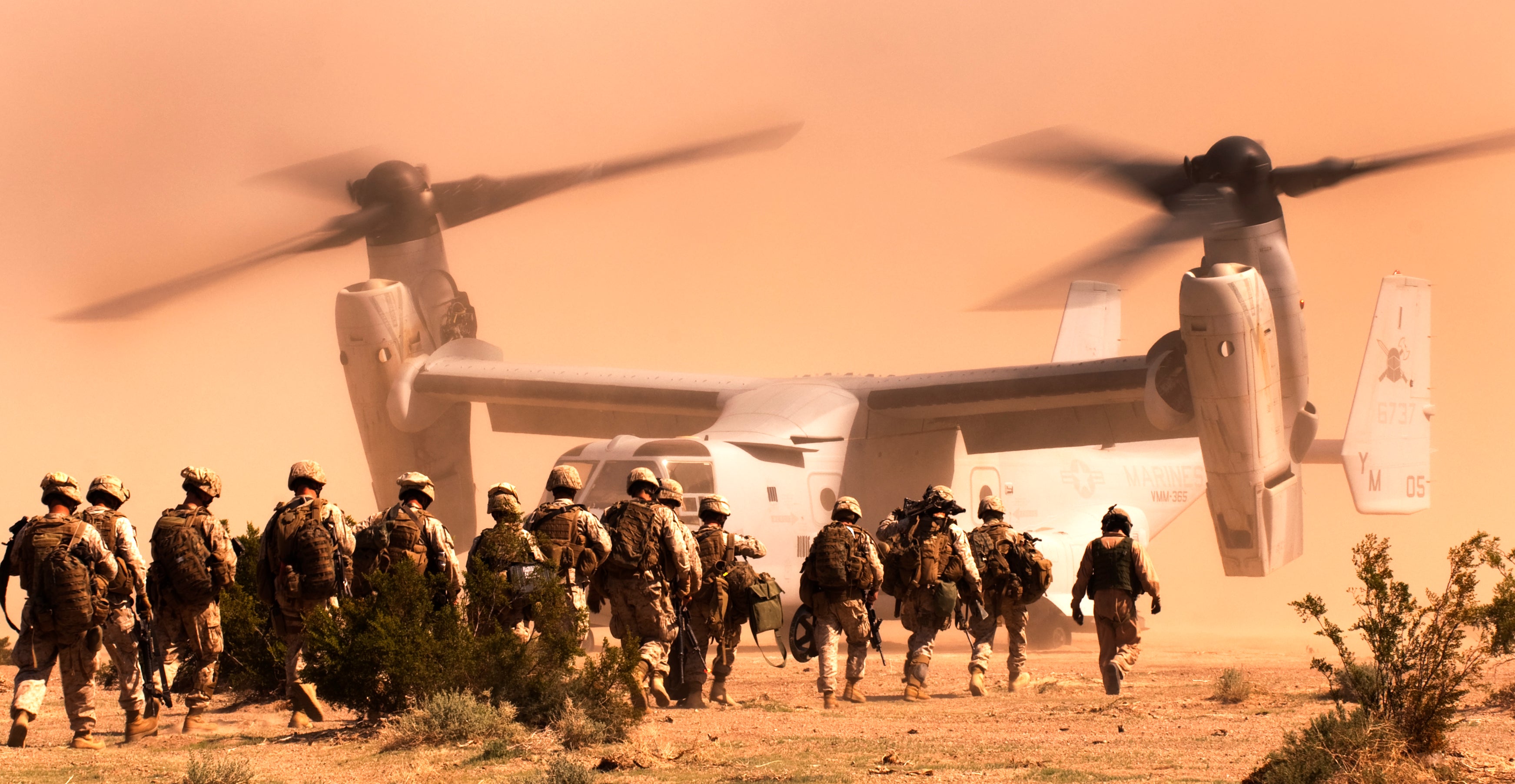
Marines and Sailors from India Company, 3rd Battalion, 3rd Marine Regiment, make their way to an MV-22 Osprey of Marine Medium Tiltorotor Squadron (VMM) 365 at Marine Corps Air Ground Combat Center Twentynine Palms, California (US Marine Corps)
As with many modern military aircraft built entirely from scratch, cost overruns began to plague the Osprey, as well as a number of high-profile training accidents. Detractors believed that the Osprey was an inherently dangerous aircraft, particularly in the case of engine failure, even though one engine can drive both rotors through a system of interconnected drive shafts. Pilots also had to learn how to fly the Osprey, because it was neither an airplane nor a pure helicopter. !!!error: Indecipherable SUB-paragraph formatting!!! to Bell’s chief Osprey test pilot Bill Leonard,
One of the biggest problems we’ve had in the [pilot] community is getting past the idea that it’s a helicopter that flies fast. It’s not. It’s an airplane that hovers. And if you fly the airplane like a helicopter, yes, it’s very difficult to fly as a helicopter. And if you do that, you have a very good chance of having a problem with controllability because of the way the aircraft operates. If you fly it like an airplane and you are willing to take the time to understand the capabilities of it in helicopter, it’s a very, very easy airplane to fly.
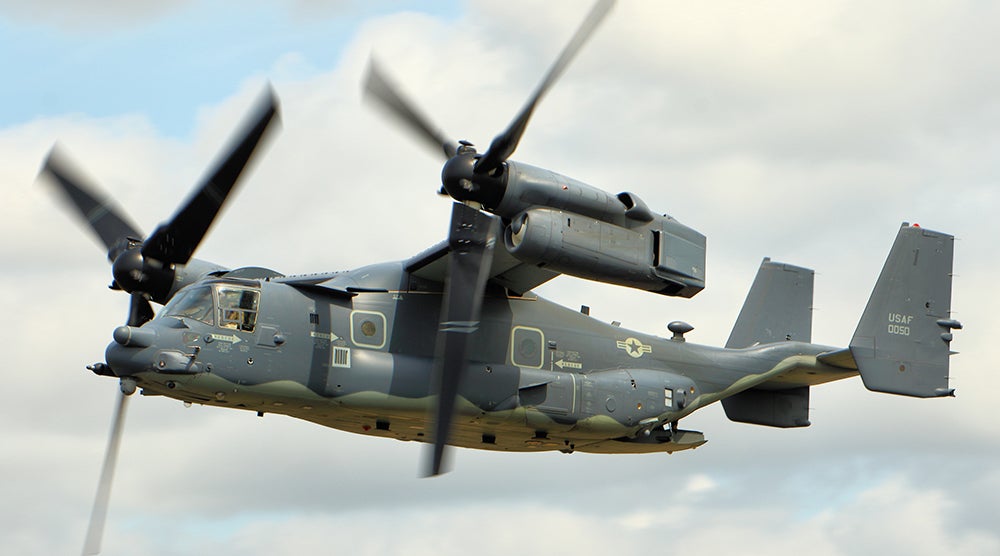 !!!CAPTION ERROR: MAY BE MULTI-LINE OR CONTAIN LINK!!!
!!!CAPTION ERROR: MAY BE MULTI-LINE OR CONTAIN LINK!!!
Though three crashes in the early years of development led to a total of 30 deaths, the Osprey has since matured into an effective and safe aircraft, and the aircraft that critics once deemed unsafe now has a !!!error: Indecipherable SUB-paragraph formatting!!! that rivals traditional military rotorcraft. Marine Corps V-22s eventually replaced the venerable !!!error: Indecipherable SUB-paragraph formatting!!! , and were first deployed to Afghanistan in 2009, where they took part in their first combat missions and continue to see service there today. For the US Air Force, the CV-22 Osprey has also become valuable in special operations missions where their range and speed (up to 350 mph) aid in the rapid insertion of special forces, and work continues to develop the Osprey for the combat search and rescue (CSAR) role. The Navy also plans to use the Osprey to replace the !!!error: Indecipherable SUB-paragraph formatting!!! for Carrier Onboard Delivery (COD).
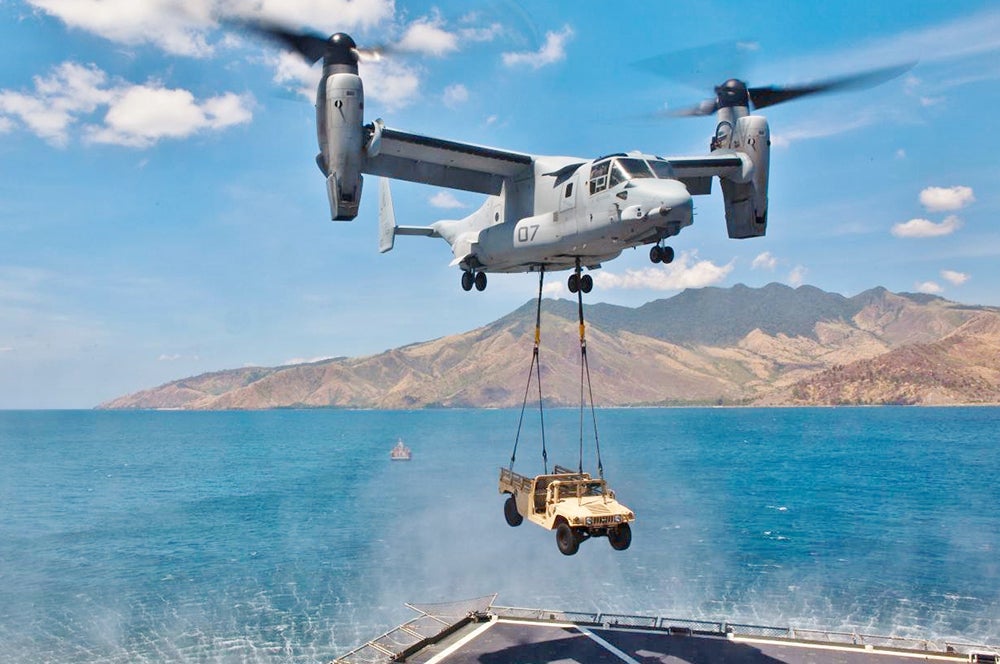 !!!CAPTION ERROR: MAY BE MULTI-LINE OR CONTAIN LINK!!!
!!!CAPTION ERROR: MAY BE MULTI-LINE OR CONTAIN LINK!!!
!!! UNKNOWN CONTENT TYPE !!!
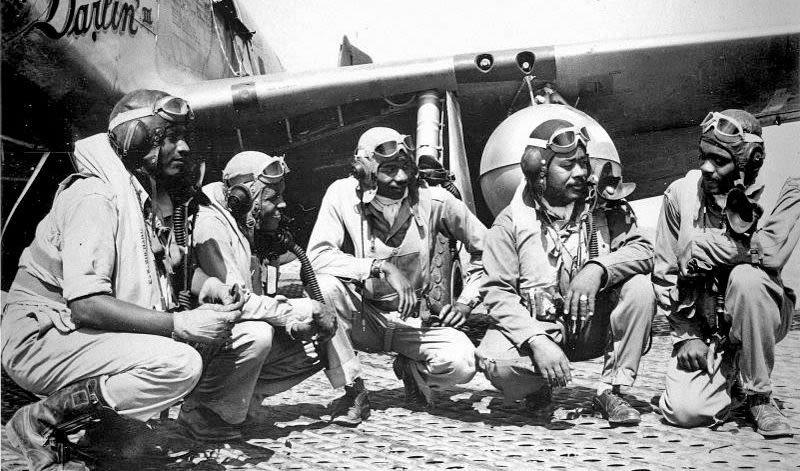
Pilots of the 332nd Fighter Group “Tuskegee Airmen” at Ramitelli, Italy in 1944. From left to right: Lt. Dempsey W. Morgan, Lt. Carroll S. Woods, Lt. Robert H. Nelson, Jr., Capt. Andrew D. Turner, and Lt. Clarence P. Lester. (US Air Force)
March 19, 1941 – The 99th Pursuit Squadron, better known as the Tuskegee Airmen, is constituted. If one were to look at photographs of WWII, it would be relatively easy to reach the conclusion that WWII was very much a white man’s war. However, when the war began, 2.5 million African American men registered for the draft, and at least 1 million went on to serve either as draftees or enlisted personnel in all the branches of the US military. However, with a few notable exceptions, the overwhelming majority were relegated to support roles such as cooks or drivers. The US military was still a segregated organization with African Americans serving in segregated units. Until the formation of the !!!error: Indecipherable SUB-paragraph formatting!!! , no African American had ever served as a military pilot.
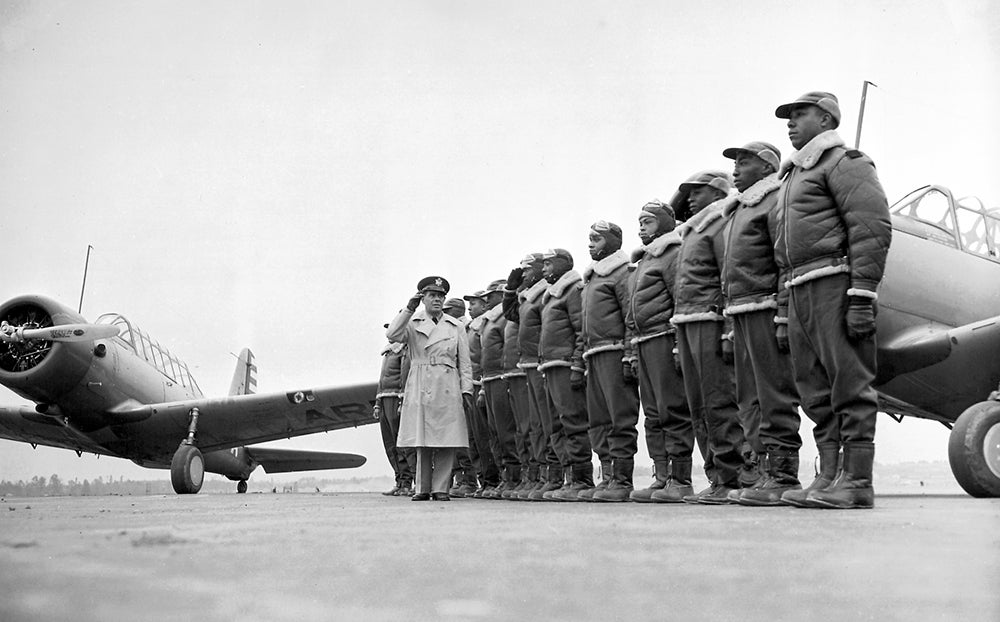
Maj James A. Ellison reviews first class of Tuskegee Airmen in 1941 (US Air Force)
According to the US census, there were only 124 black pilots in all of the US. But in 1939, Congress passed the Civilian Pilot Training Act, and !!!error: Indecipherable SUB-paragraph formatting!!! in Alabama began training African American pilots as part of the !!!error: Indecipherable SUB-paragraph formatting!!! . In January 1941, the War Department announced plans to create a “Negro pursuit squadron” to be manned by graduates of the Tuskegee program, and the !!!error: Indecipherable SUB-paragraph formatting!!! was activated on March 22, 1941 at !!!error: Indecipherable SUB-paragraph formatting!!! in Illinois with 271 enlisted men trained in ground support. Pilot training for the 99th began the following June. Initially, the squadron included 47 officers and 429 enlisted men, but the unit was still segregated, and the construction contract for the base was awarded to an African American contractor. By April 1942, the 99th was considered ready for combat, and the squadron was sent to North Africa as part of the 33rd Fighter Group.
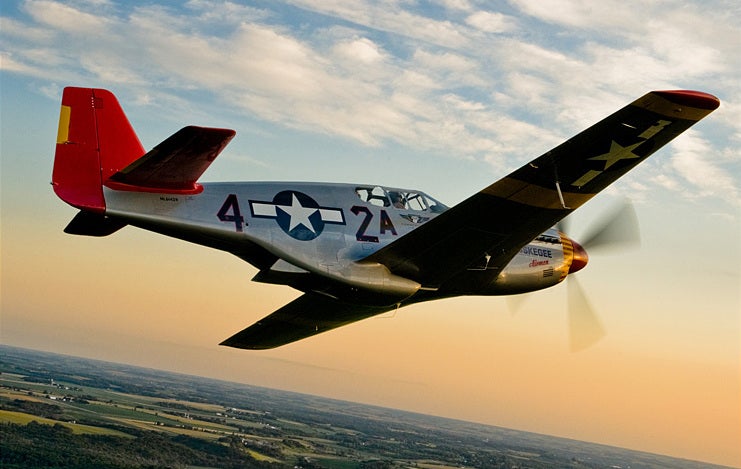 !!!CAPTION ERROR: MAY BE MULTI-LINE OR CONTAIN LINK!!!
!!!CAPTION ERROR: MAY BE MULTI-LINE OR CONTAIN LINK!!!
The Tuskegee Airmen, nicknamed the Red Tails due to the distinctive red paint on the empennage of their !!!error: Indecipherable SUB-paragraph formatting!!! flew their first combat mission against a strategic island in the Mediterranean Sea in the run up to the !!!error: Indecipherable SUB-paragraph formatting!!! . During the !!!error: Indecipherable SUB-paragraph formatting!!! , the 99th provided close air support for the US 5th Army at Foggia and during the !!!error: Indecipherable SUB-paragraph formatting!!! , and for French and Polish forces during the !!!error: Indecipherable SUB-paragraph formatting!!! . On July 2, 1943, 1st Lt. Charles Hall of the 99th claimed the first enemy aircraft destroyed by a Tuskegee Airman when he downed a German !!!error: Indecipherable SUB-paragraph formatting!!! over southwestern Sicily.
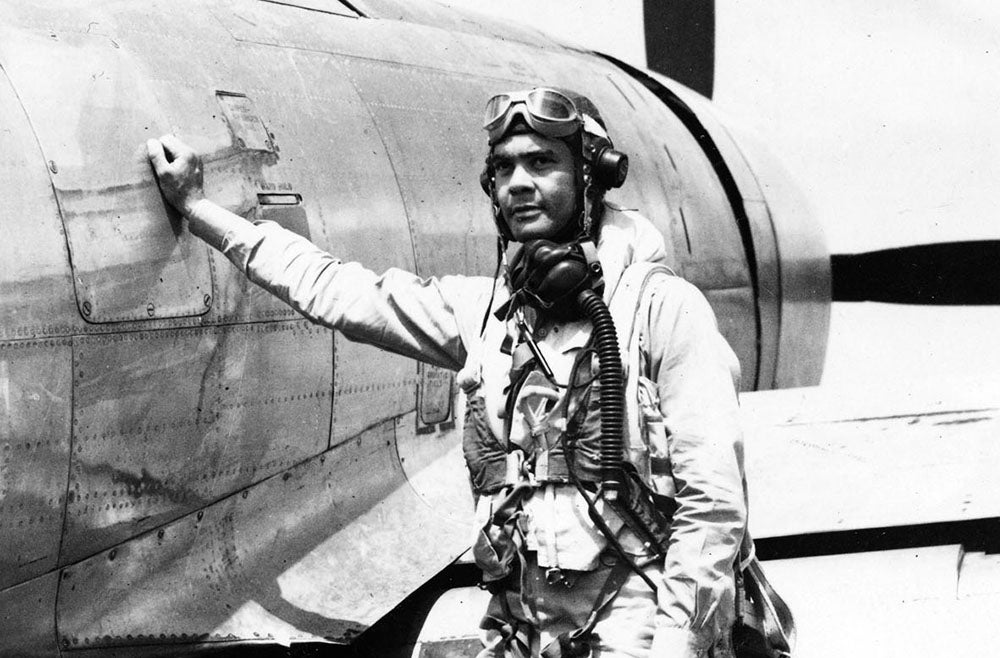 !!!CAPTION ERROR: MAY BE MULTI-LINE OR CONTAIN LINK!!!
!!!CAPTION ERROR: MAY BE MULTI-LINE OR CONTAIN LINK!!!
The 99th continued to escort bombers and provide air cover during the Italian campaign, and the squadron was awarded the first of three !!!error: Indecipherable SUB-paragraph formatting!!! during the period June-July 1943 for its actions during the landings at Sicily. In all, the 99th flew over 15,000 sorties and lost 66 pilots in combat, one of the lowest loss rates in the US Army Air Forces. Due in large part to exemplary service of the Tuskegee Airmen, along with that of other African American servicemen, President Harry S. Truman issued !!!error: Indecipherable SUB-paragraph formatting!!! on July 26, 1948 which ordered the integration of the US military and stated that “there shall be equality of treatment and opportunity for all persons in the armed forces without regard to race, color, religion, or national origin.”
!!! UNKNOWN CONTENT TYPE !!!
Short Takeoff
!!! UNKNOWN CONTENT TYPE !!!
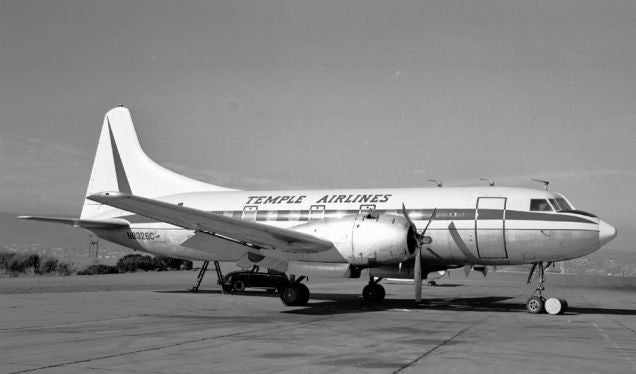
(NASA)
March 16, 1947 – The first flight of the Convair CV-240, originally designed as a larger, more modern replacement for the !!!error: Indecipherable SUB-paragraph formatting!!! . Like the famed Douglas aircraft, the prototype 240 was unpressurized, and the airlines’ desire for a pressurized fuselage led Convair to redesign the 240. The fuselage was lengthened to add 10 more seats, which brought initial capacity to 40 passengers. Continued development of the CV-240 resulted in a number of variants, each one with longer fuselage and wings, and the eventual incorporation of turboprop engines. The CV-240 was the first private aircraft to be used in a US presidential election when John F. Kennedy flew in a CV-240, named Caroline in honor of his young daughter. The 240 also served with the US Air Force as the C-131 Samaritan and with the US Navy as the R4Y. Just under 1,200 aircraft were produced between 1947-1954, and though largely retired, a handful remain in service as cargo aircraft.
!!! UNKNOWN CONTENT TYPE !!!
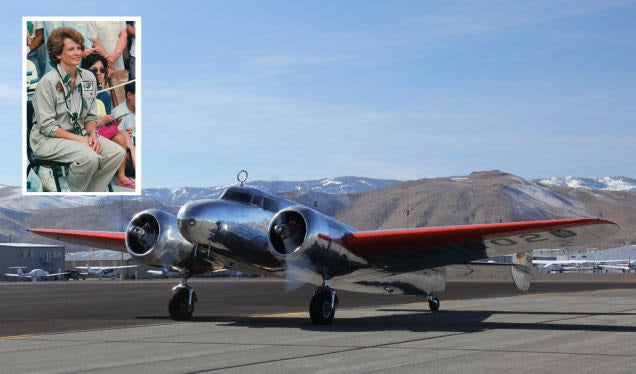 !!!CAPTION ERROR: MAY BE MULTI-LINE OR CONTAIN LINK!!!
!!!CAPTION ERROR: MAY BE MULTI-LINE OR CONTAIN LINK!!!
March 17, 1997 – Linda Finch takes off on a flight to recreate and complete Amelia Earhart’s ill-fated round-the-world flight. Finch, an aviatrix and businesswoman from San Antonio, TX, took off in a restored 1935 !!!error: Indecipherable SUB-paragraph formatting!!! that had been prepared identically to Earhart’s plane. Finch’s flight took 10 weeks to complete while flying legs of 8 to 18 hours at a time. She stopped at 36 different locations in 18 countries and covered approximately 26,000 miles. Finch’s Electra has been acquired by the !!!error: Indecipherable SUB-paragraph formatting!!! in Seattle, Washington where it will be displayed. March 17 is the departure date for Earhart’s first unsuccessful attempt at circumnavigating the globe in 1937. The second attempt, in which Earhart and copilot Fred Noonan disappeared, began on July 2, 1937.
!!! UNKNOWN CONTENT TYPE !!!
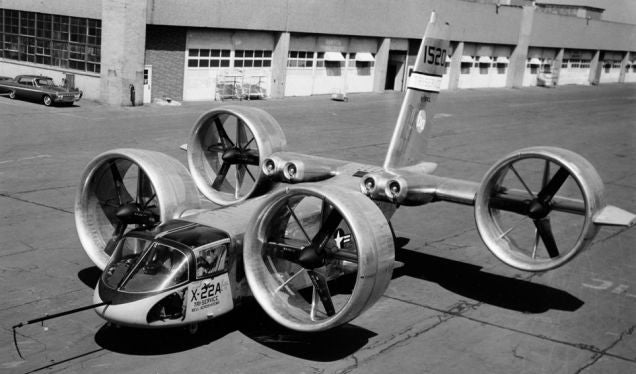 !!!CAPTION ERROR: MAY BE MULTI-LINE OR CONTAIN LINK!!!
!!!CAPTION ERROR: MAY BE MULTI-LINE OR CONTAIN LINK!!!
March 17, 1966 – The first flight of the Bell X-22, an experimental !!!error: Indecipherable SUB-paragraph formatting!!! (V/STOL) aircraft powered four !!!error: Indecipherable SUB-paragraph formatting!!! turboshaft engines grouped on the rear wing turning four large ducted fans. Developed to investigate the use of V/STOL aircraft for the transport of troops and cargo, the X-22 successfully transitioned from vertical to forward flight soon after its maiden flight, but a crash six months later led to the loss of the first prototype. Though it was the most successful aircraft of its type at the time, the hoped-for speed of 315 mph was never achieved and the project was canceled. The second prototype, the X-22A, is now on display at the !!!error: Indecipherable SUB-paragraph formatting!!! in New York.
!!! UNKNOWN CONTENT TYPE !!!
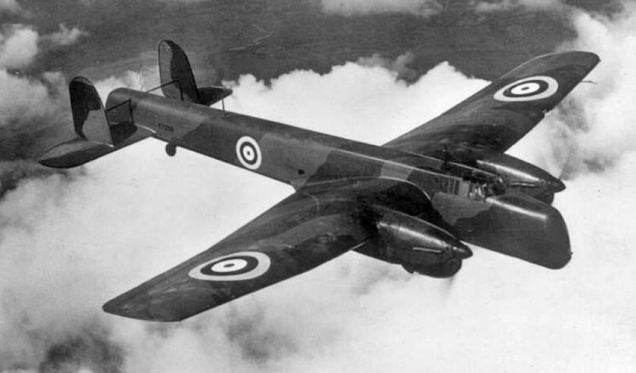
(Royal Air Force)
March 17, 1936 – The first flight of the Armstrong Whitworth Whitley, one of three twin-engine medium bombers to serve the Royal Air Force during WWII. The Whitley was introduced in 1937 to replace the !!!error: Indecipherable SUB-paragraph formatting!!! biplane bomber, and took part in the first RAF bombing raids of the German homeland, though it was essentially obsolete by the start of the war in 1939. Following the introduction of larger, four-engine bombers, the Whitley was retired from frontline service in 1942 and relegated to maritime reconnaissance duties. It also served as a glider tug, trainer, and transport aircraft. A total of 1,814 Whitleys were produced, and the bomber was fully retired at the end of the war.
!!! UNKNOWN CONTENT TYPE !!!
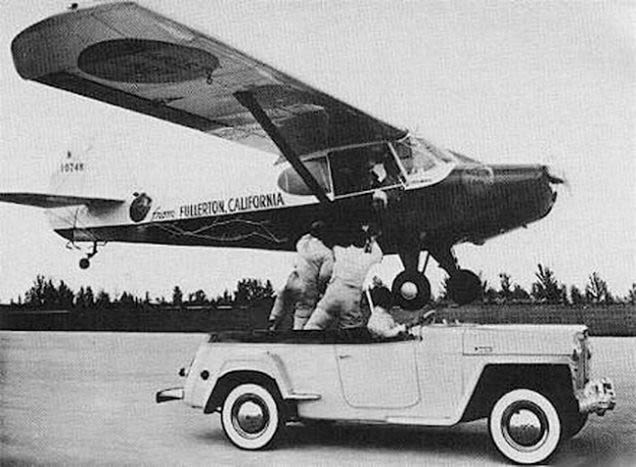 !!!CAPTION ERROR: MAY BE MULTI-LINE OR CONTAIN LINK!!!
!!!CAPTION ERROR: MAY BE MULTI-LINE OR CONTAIN LINK!!!
March 17, 1949 – The Sunkist Lady takes off in an attempt to set an endurance record. In an attempt to break the previous endurance record of 726 hours set in 1939, pilots Dick Reidel and Bill Barris of the Fullerton Air Service flew their modified !!!error: Indecipherable SUB-paragraph formatting!!! from Fullerton, California to Miami Florida, where they circled for 14 days before returning to California. There, they remained aloft over Southern California until the record was broken, eventually logging 1,008 hours in the air. The pilots were supplied with food and fuel by vehicles driving along a runway while supplies were handed up to the crew. By the time Reidel and Barris landed on April 26, they had covered more than 75,600 land miles and burned 6,552 gallons of fuel.
!!! UNKNOWN CONTENT TYPE !!!
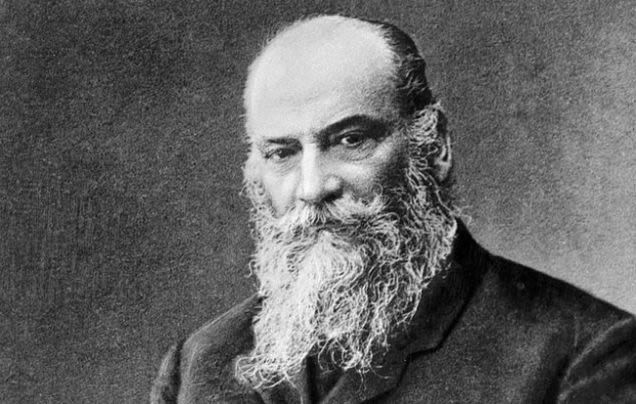
(Author unknown)
March 17, 1921 – The death of Nikolay Yegorovich Zhukovsky,
a Russian scientist who is considered the founding father of modern
!!!error: Indecipherable SUB-paragraph formatting!!!
and
!!!error: Indecipherable SUB-paragraph formatting!!!
. Born on January 17, 1847, Zhukovsky was the first to undertake the study of airflow in the hopes of one day creating a flying machine, and created the world’s first Aerodynamic Institute near Moscow in 1904, where he is often called the Father of Russian Aviation. Zhukovsky was the first to explain the origin of lift mathematically, and the first to determine that the amount of lift of a body is proportional to its velocity and the circulation of the air around it. Zhukovsky also constructed Russia’s first wind tunnel.
!!! UNKNOWN CONTENT TYPE !!!
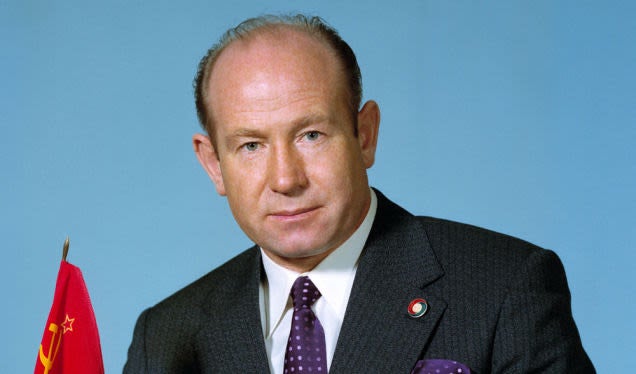
(NASA)
March 18, 1965 – Cosmonaut Alexei Leonov becomes the first person to “walk” in space. Leonov was one of 20 Soviet Air Force pilots selected as the first cosmonauts in 1960, and his first flight to space was on board !!!error: Indecipherable SUB-paragraph formatting!!! as part of Russia’s manned space program. During Leonov’s 12-minute-long extravehicular activity (EVA), a defect in the design of his spacesuit caused it to inflate to the point where he could not re-enter the capsule. He had to release a pressure valve on the suit and only then just barely made it back inside. Leonov returned to space for the second and last time in 1975 as commander of Soyuz 19, part of the !!!error: Indecipherable SUB-paragraph formatting!!! in which a Soviet and an American space capsule docked together in space to mark the symbolic end of the !!!error: Indecipherable SUB-paragraph formatting!!! .
!!! UNKNOWN CONTENT TYPE !!!
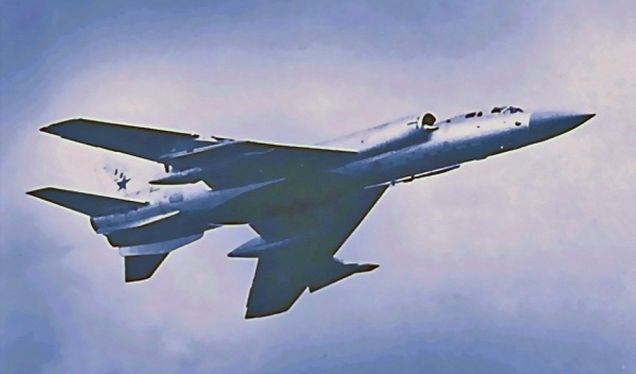
(US Navy)
March 18, 1961 – The first flight of the Tupolev Tu-28, a long-range interceptor introduced to the Soviet Air Force in the late 1960s and the largest interceptor to fulfill that role ever to enter service. To protect Russia’s vast territory, Tupolev designed a supersonic interceptor with an enormous fuel load, radar, and the best air-to-air missiles available at the time. The Tu-28, also called Tu-128 by the Soviets and designated Fiddler by NATO, was never intended as a dogfighter; rather, it’s mission was to intercept American bombers such as the !!!error: Indecipherable SUB-paragraph formatting!!! before the bombers could reach their targets. The Tu-28 had an estimated top speed of Mach 1.5 and a range of 1,600 miles, but could not fly above 15,600 feet when armed. Just under 200 were built, and the type served for nearly 30 years.
!!! UNKNOWN CONTENT TYPE !!!
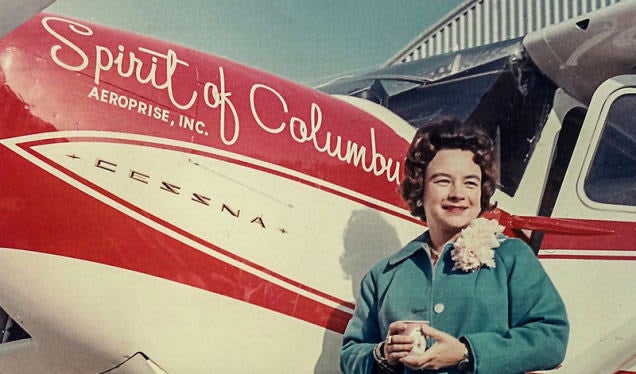 !!!CAPTION ERROR: MAY BE MULTI-LINE OR CONTAIN LINK!!!
!!!CAPTION ERROR: MAY BE MULTI-LINE OR CONTAIN LINK!!!
March 19, 1964 – Geraldine Mock becomes the first woman to fly around the world. Mock took off on March 19 from Columbus, Ohio piloting a single-engine !!!error: Indecipherable SUB-paragraph formatting!!! (N1538C) christened Spirit of Columbus and completed the circumnavigation on April 17 after 29 days. Her flight included 21 stopovers and covered 22,860 miles. In recognition of this feat, Mock was awarded the !!!error: Indecipherable SUB-paragraph formatting!!! from the Féderation Aéronautique Internationale in 1965. In 1970, Mock published a book about her trip titled Three-Eight Charlie . She also holds numerous speed and distance records for a woman pilot, was the first to fly across the Pacific Ocean in a single-engine aircraft, and the first to cross both oceans. Spirit of Columbus now resides at the Smithsonian’s !!!error: Indecipherable SUB-paragraph formatting!!! near Washington, DC.
!!! UNKNOWN CONTENT TYPE !!!
Connecting Flights
!!! UNKNOWN CONTENT TYPE !!!
!!! UNKNOWN CONTENT TYPE !!!
!!! UNKNOWN CONTENT TYPE !!!
!!! UNKNOWN CONTENT TYPE !!!
!!! UNKNOWN CONTENT TYPE !!!
If you enjoy these Aviation History posts, please let me know in the comments. And if you missed any of the past articles, you can find them all at
!!!error: Indecipherable SUB-paragraph formatting!!!
. You can also find more stories about aviation, aviators and airplane oddities at
!!!error: Indecipherable SUB-paragraph formatting!!!
.
!!! UNKNOWN CONTENT TYPE !!!
 user314
> ttyymmnn
user314
> ttyymmnn
03/19/2019 at 12:49 |
|
Nothing much to add to today’s entry, just A-10s escorting MV-22s:
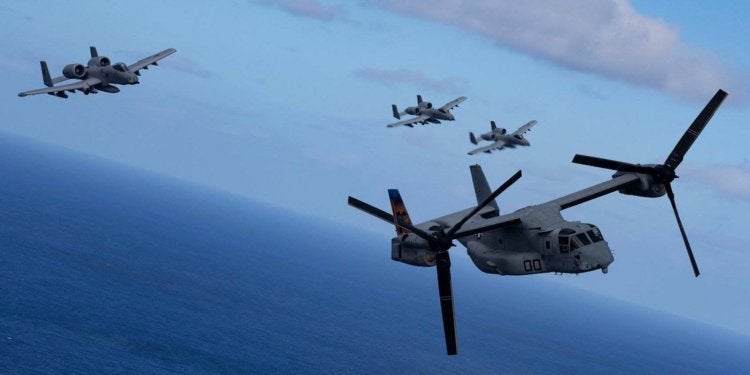
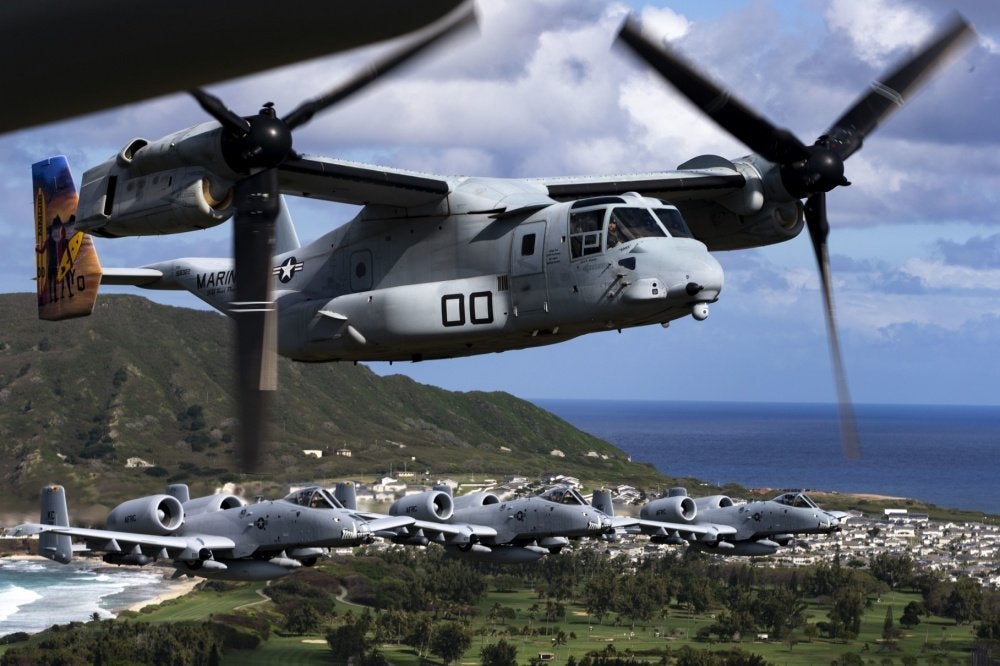
 You can tell a Finn but you can't tell him much
> ttyymmnn
You can tell a Finn but you can't tell him much
> ttyymmnn
03/19/2019 at 13:46 |
|
As bad as Eagle Claw went, their follow up had even more potential for disaster. Landing a C-130 in a soccer stadium, then loading it up with the hostages and taking off again from inside the stadium seems like a pretty hair- brained plan if you’re being generous .
 ttyymmnn
> You can tell a Finn but you can't tell him much
ttyymmnn
> You can tell a Finn but you can't tell him much
03/19/2019 at 14:03 |
|
Look for the videos on YouTube of the modified Herk getting its wings burned off by the braking rockets. Even with the O sprey, I wonder if such an audacious mission ever really had a chance.
 user314
> ttyymmnn
user314
> ttyymmnn
03/19/2019 at 14:22 |
|
Eh, the accident happened because they were landing manually, and someone hit the wrong switch at the wrong time. Not saying Murphy’s Law c ouldn’t have hit them during the mission, but that particular foul-up could have been avoided.
 BaconSandwich is tasty.
> ttyymmnn
BaconSandwich is tasty.
> ttyymmnn
03/19/2019 at 16:31 |
|
That X-22 is so neat looking. I've wondered why a design like that hasn't been successful.
 ttyymmnn
> BaconSandwich is tasty.
ttyymmnn
> BaconSandwich is tasty.
03/19/2019 at 19:00 |
|
Back then it was about power and controlability. Nowadays, it’s here’s plenty of power and quadcopters are a common thing. You might see one come back as a bigger lifter. .